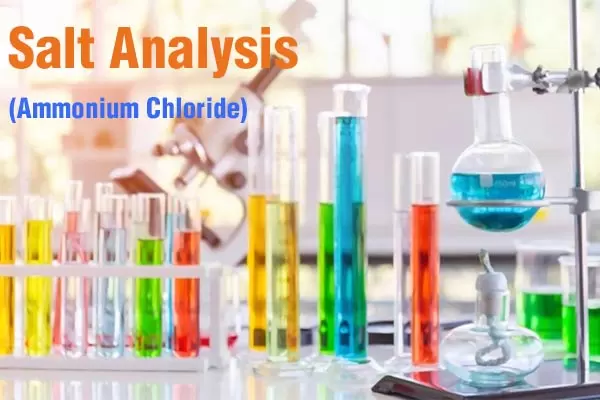Analysis of Ammonium Chloride

General
Ammonium chloride (NH₄Cl) is a cryptic crystalline compound with a multitude of applications, spanning various fields from industry to medicine. Its enigmatic complexity and linguistic dynamism make it a prime subject of interest. Here is a brief overview of its properties, uses, and potential toxicity:
Chemical Characteristics
Molecular Formula: NH₄Cl
Molecular Weight: 53.49 g/mol
Appearance: A white crystalline solid or powder
Solubility: Ammonium chloride is highly soluble in water, releasing ammonium (NH₄⁺) and chloride (Cl⁻) ions
Melting Point: Sublimes at 338 °C
pH: In aqueous solutions, it exhibits a weakly acidic nature with a pH of 4.6-6 (depending on concentration)
Upon immersion in water, ammonium chloride breaks down into its respective ions of ammonium and chloride. Under extreme heat, it decomposes into ammonia and hydrogen chloride gas.
Industrial Uses:
Ammonium chloride has vide industrial used some of the uses are:
Metalwork and Electroplating: Frequently employed as a flux in metalwork and galvanizing to eliminate oxides from the metal surface.
Agriculture: Serves as a source of nitrogen in fertilizers, particularly in the cultivation of rice.
Batteries: Used as an electrolyte in dry cell batteries, namely zinc-carbon batteries.
Pharmaceutical and Medical Applications:
Cough Remedies: Acts as an effective expectorant, aiding in the loosening of respiratory tract mucus.
Diuretic and Acidifying Agent: Occasionally utilized to acidify urine in the treatment of urinary tract infections and to restore electrolyte levels.
Food Industry:
Food Additive (E510): Functions as a flavoring agent, especially in salty licorice.
Leavening Agent: Occasionally incorporated in baking to assist with dough conditioning.
Toxicity and Security
Ammonium chloride is widely considered to be safe in regulated quantities, particularly in the realms of food and pharmaceuticals. However, excessive amounts can be perilous.
Acute Toxicity: Ingesting large quantities can result in queasiness, vomiting, and abdominal pain. Inordinate doses can disturb the acid-base equilibrium in the body, triggering metabolic acidosis.
Chronic Exposure: Prolonged or recurrent exposure, specifically through inhalation in industrial environments, may lead to respiratory irritation and aggravate conditions like asthma.
Skin and Eye Aggravation: Contact with ammonium chloride can cause irritation of the skin and eyes, particularly in its concentrated or solid form.
Inhalation Hazards: Inhaling ammonium chloride dust or fumes can cause discomfort in the respiratory system or even harm in concentrated amounts.
Security Precautions
When dealing with ammonium chloride utilize personal protective gear (PPE), such as gloves and eye protection, especially in industrial settings.
Ensure adequate ventilation to minimize the risks of inhalation.
Store in a cool, dry area away from incompatible substances, such as strong acids and bases.
The Analysis of Ammonium Chloride is part of the salt analysis and a schematic scheme is followed for the analysis of the given inorganic salt.
The analysis of Ammonium Chloride to be written in a practical file is mentioned below
| Test | Observation | Inference |
| Preliminary Test | ||
| Color | Colorless | Salts of Cu2+, Ni2+, Co3+, CrO4 2- , Fe3+ etc. may be absent |
| Odor | Ammonical odor | NH4 1+ ions may be present |
| Dry Test: | ||
Dilute Sulphuric acid test: Take 0.5 gm of Salt and then add Dilute H2SO4 | No Effervescence of CO2 | CO3 2- ions absent |
Concentrated Sulphuric Acid Test: Take 0.5 gm of salt and then add Concentrated H2SO4 dropwise from the side of the test tube | Colorless gas with a suffocating odor | Cl1- ions present |
Confirmative test for Chloride ions | ||
MnO2 Test: Take 0.5 gm of Salt and add 1.0 gm of MnO2 then add Conc. H2SO4 dropwise. | Dense fumes with suffocating odor give thick white fumes with Ammonia vapors | Cl1- ions confirmed |
Silver nitrate Test: 0.5 gm of Salt add Distilled water then add AgNO3 Solution | White precipitates soluble in Ammonium Hydroxide (NH4OH solution) | Cl1- ions confirmed |
The acidic radical present in the salt is Cl1- ion | ||
Test for Basic radicals (Wet Test) | ||
Solubility 2 gm of salt and add water | Clear solution (original Solution (O.S.)) | Water soluble salt. |
O.S. + Dilute NaOH Take 5 ml of O.S. and add Dilute NaOH solution if required heat gently | Ammonical odor | Group 1 Present NH4 1+ ions present |
Confirmative Test for NH4 1+ ions | ||
O.S. + Conc. NaOH | Strong Ammonical Odor | NH4 1+ ions Confirmed |
O.S. + Nessler’s Reagent | Yellow-orange ppt’s | NH4 1+ ions Confirmed |
The Basic radicals are NH4 1+ ions. | ||
The Salt is NH4Cl (Ammonium Chloride) | ||
